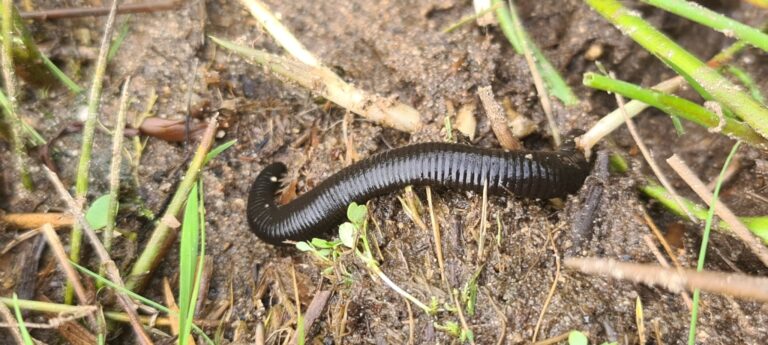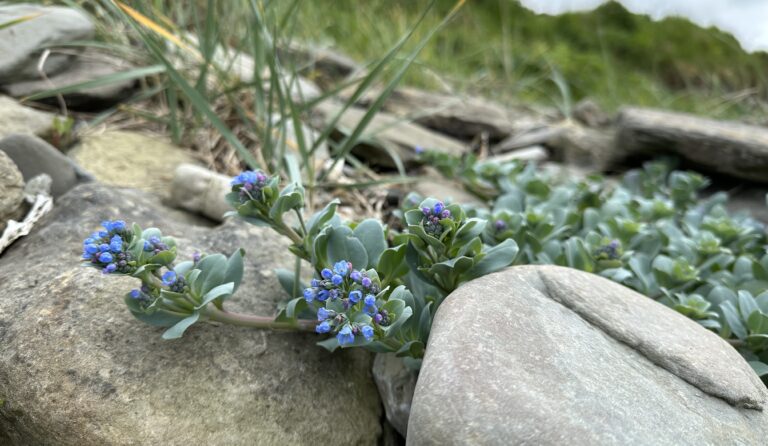Gaelic: Muir-tèachd
Where to look
The Moon jellyfish, Britain’s most common jellyfish, is widespread in the oceans of the world. It is most often found near the coast and in upwelling areas, where its plankton prey occurs in higher concentrations. You can usually see these jellyfish floating just below the surface of the water in estuaries, harbours, and sea lochs, and washed up on the beaches of north Scotland.
We don’t find moon jellyfish here every year. Some years they form massive local populations in some areas but are totally absent in other places. The most spectacular swarms are usually in late summer when the jellyfish are at their largest.
How to look / what to look out for
Look out for a round, dome-shaped clear jelly, 5-40cm in diameter, with four horse-shoe shaped markings around the middle. The horse-shoe shaped structures are sex organs and they are usually coloured purple. The dome, or bell, of jelly is covered in mucus (slime!) and has a fringe of short tentacles.
Moon jellies swim by pulsing the bell, pushing themselves slowly through the water. They are not strong swimmers and are largely at the mercy of the tides, currents, and storms. This is why large numbers can collect in bays and harbours and may be stranded on beaches.
Don’t panic!
Moon jellies are not dangerous. The moon jelly’s sting is rarely powerful enough to pierce our thick skin, and most people have only a slight reaction to it if anything at all. However, it is best not to touch these animals as they are fragile and easily damaged.
Fascinating facts
Life cycle: Did you know that Moon jellyfish have two stages to their lifecycle: a polyp and a medusa? The bell- shaped jellyfish is the adult – called a medusa – and they are male or female. To breed males release sperm into the water to fertilise the eggs in the females. Eggs are then released into the water and a tiny larva hatches from each egg and floats in the open sea for some time. The larva attaches to a rock in shallow water and grows into an umbrella-shaped polyp. The polyp grows and produces several new jellyfish that grow into adults. Each medusa can live for about 6 months, but the polyp can last for 25 years!
Check out this video of polps feeding:
Feeding: The threadlike tentacles around the edge of the dome have tiny stings that are
like minute harpoons fired by springs. They are designed to catch tiny animals in
plankton, but most food is trapped in the slime on the jellyfish and flows to the edges
where it is passed to the mouth parts by tentacles.
Predators: Moon jellies are the favourite prey of some open ocean predators, like ocean sunfish, leatherback turtles and other jellyfish.
Edible: Moon jellyfish are used in cuisine in parts of Asia, in both sweet and savoury dishes.
Glow in the dark: I have read that they glow in the dark, but I’ve never seen this myself – have you?
Jellyfish are the oldest multi-organ animal: with fossil evidence indicating they existed over 500 million years ago, predating dinosaurs.
Jellyfish have been studied widely by scientists, and moon jellies even went into space as an experiment aboard the Space Shuttle Columbia in 1991.
Jellyfish are 95% water, and have no brain, heart or blood – but they do have a sort of nervous system or “nerve net” that allows them to sense light, balance, chemical changes and touch.
Human impacts
Scientists believe that moon jellies and other jellies thrive in areas that are particularly affected by human activity. Overfishing, ocean warming, and pollution are all factors that reduce moon jellies’ predators and competitors and increase their prey. These results provide a more favourable environment for this species. As people continue to increase our ocean activities, the Moon Jelly may become one of the more successful species in the open ocean.
Images courtesy: The Wildlife trusts







